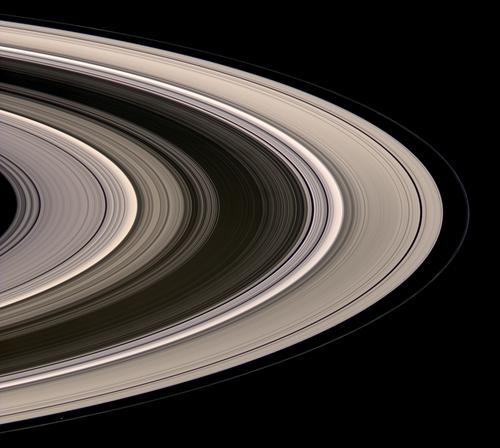Saturn’s enigmatic rings may be much older and also much more massive than previously thought, according to a new study. Because Saturn’s rings look so clean and bright, it was thought the rings were younger than the planet itself, which is estimated to be about 4.5 billion years old. But using data from the Cassini spacecraft’s UVIS (Ultraviolet Imaging Spectrograph) instrument, Principal Investigator Dr. Larry Esposito and his team used computer simulations to study colliding particles in Saturn’s rings and their erosion by meteorites. Their results support the possibility that Saturn’s rings formed billions of years ago, perhaps at the time when giant impacts excavated the great basins on the Moon. The findings also suggest that giant exoplanets may also commonly have rings.
“Both Cassini observations and theoretical calculations can allow the rings of Saturn to be billions of years old. This means we humans are not just lucky to see rings around Saturn. This would lead us to expect massive rings also to surround giant planets circling other stars,” said Esposito.
Also, simulations run by Esposito’s colleagues Glen Stewart and Stuart Robbins from the University of Colorado showed that Saturn’s ring particles clump together, meaning previous estimates of the mass might be too low, perhaps by a factor of 3.

Meteorites slowly grind and shatter the particles in the ring. Gradually, a layer of dust and fragments builds up and covers each particle, making each particle more massive while “cleaning up” the rings.
Recycling of ring material extends their lifetime and reduces the darkening that was expected previous to this study if the rings were older.
One problem with this proposal for more massive and ancient rings is that the Pioneer 11 space mission to Saturn in 1979 measured the ring mass indirectly by observing charged particles created by cosmic rays bombarding the rings.
“Those mass estimates were similar to the ones from Voyager star occultations, apparently confirming the previous low mass value. However, we now recognize that the charged particles are double-valued. That means they could arise from either a small or large mass. We now see that the larger mass value could be consistent with the underestimates due to ring clumpiness,” said Esposito.
Source: European Planetary Science Congress


These findings bring into question our knowledge and understanding of the ring systems of Jupiter, Uranus and Neptune. While the ring systems of Uranus and Neptune vary greatly in structure compared to Saturn and are also considered ancient, questions concerning their formation and mass should now be reexamined in light of these new findings.
This is good. I learned of the theory that Saturn’s rings were volatile and temporary before I read Larry Niven’s “World of Ptaavs”, and I was bummed out that the part of the story where the Thrint saw Saturn with its rings a billion years ago couldn’t happen.
Now it’s scientifically accurate again! 🙂
This makes perfect sense. When other than the period of heavy bombardment could enough material be blown into orbit to create rings of this size? Since that event happened billions of years ago and nothing like it has happened since, it stands to reason that the rings are this old.
It never sat well with me that Saturn’s rings were supposed to be short lived and that we just happened to be around to witness them at the right time by pure luck.
This is an interesting if not conclusive find…
A small thought. As scientists we tend to cling to the principal that we inhabit neither a ‘privileged’ location nor time in the Universe. Therefore the arguement goes, “Surely the rings of Saturn must be both long lived and a common formation in the Universe.”
However, if some things in this Universe are transitory, as surely they are, then we would be living in a peculiarly privileged time if we saw the sum total of none of them. Examples here could include planetary nebulae, which have a very short life before they are no longer illuminated by their central white dwarf (the two part company very quickly on cosmological time scale).
The question is then, just how many short lived or rare phenomena would we expect to see in our perfectly ordinary corner of the Universe and how do we distinguish them from the commonplace?
Just a little thought to start off the day…
Greg –
you don’t need heay bombardment to break up a moon to form rings – a body spiraling towards a planet wll break up (if conditions are right) as the gravitational gradient accross the body breaks it up. This is supported by the fact that only massiver planets appear to have rings (the widyj of the rings is determined by the oblique-ness of tyhe parent planet and the mass of the moon which breaks up.
And while i agree that the rings happening to be here at the same time as us is unlikely if the rings are transient – ring systems formed in the manner I descibe could occour regularly – especially in systems such as Jupiter and its moons in which multiple moons interact in complex ways with each other and the host planet
..sorry about the typo’s in the above – in a hurry!
Just as I always thought – science fiction leads and science fact follows. Niven rules. All we need to find now is a Ring World around a nearby star. [hint: look for a big IR signature guys!] ;-))